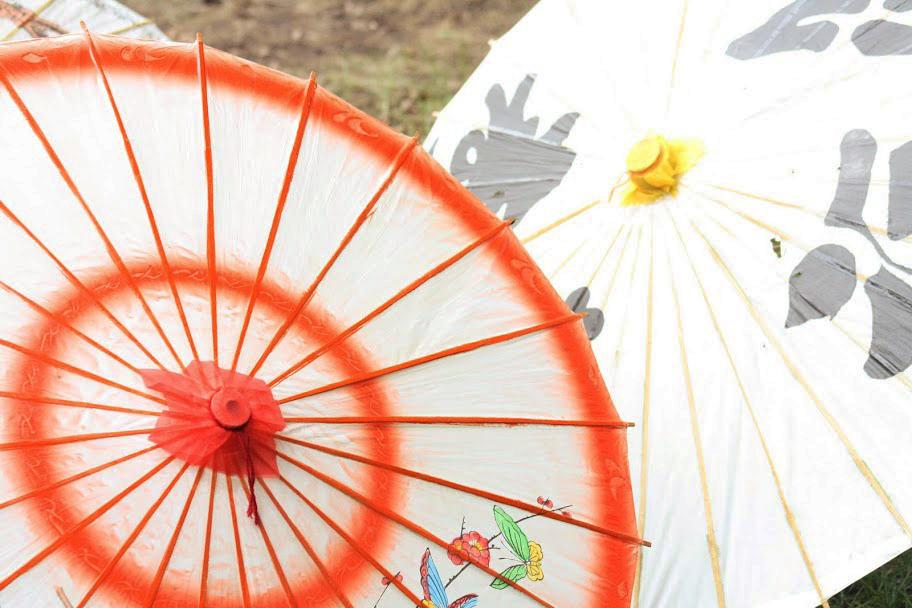Thousands of St. Louisans disregarded the risk of rain this Labor Day weekend in order to experience Japanese art and culture at the Botanical Garden’s annual Japanese Festival.
“The Japanese Festival started over 30 years ago to showcase the Japanese Garden in the Missouri Botanical Garden, which is one of the largest in the USA,” Mari Alford Watanabe, an instructor at the Japanese School of St. Louis, said. “It used to be just one day, but today it’s held over all 3 days of the Labor Day weekend, and can have as many as 50,000 visitors.”
Though turnout was depressed by the poor weather, the festival’s myriad of activities and demonstrations enticed thousands to attend despite the possibility of rain. From Japanese taiko drum demonstrations, to a traditional tea ceremony, to face painting and origami in the Children’s Game Area, the festival offered insight into a rich segment of the St. Louis community. Naomi Hamamura, the owner of Sansui Japanese Restaurant in St. Louis, displayed his skills in ice sculpture in the Spink Pavilion. Masaji Terasawa, the “Candyman,” entertained spectators with street theatre, including spun-sugar sculptures and routines with Japanese paper fans, by the fountain near the garden’s entrance.
Near the main entrance to the gardens, visitors found a selection of booths from Japanese restaurants and organizations, serving unfamiliar foods like octopus balls and Okonomiyaki, savory Japanese vegetable pancakes, alongside more familiar fare like sushi and teriyaki chicken. One stand offered green tea and red bean ice cream to visitors with a sweet-tooth for exotic flavors.
Beneath the broad white tent that provide tables, chairs, and shelter from the periodic drizzle of rain, Botanical Gardens volunteers directed diners to either compost, recycle, or throw away their food and utensils based on the type of material. Three large plastic containers, one each for compost, trash, and recycling, replaced the typical two for trash and recycling in a relatively new feature of Botanical Gardens events.
“For the Japanese festival, this is actually the first time that we’re doing it, but we did it last year for the Best of Missouri Market and we will continue to do it,” Botanical Gardens volunteer manager Jackie Juras said. “We will continue to inform our vendors that they need to be in compliance. We still have some trash but for the most part we’re able to compost or recycle most of the stuff that we have.”
The festival’s vibrant cultural displays are the product of a year’s worth of planning and the assistance of local volunteers. Along with fellow Ladue freshman Kathryne Lampkin, freshman Rachel Wagner-Muns worked at the face painting booth. Face painting designs included brightly colored sushi, flowers, and characters from Japanese anime. On Saturdays, Lampkin and Wagner-Muns attend the Japanese School of St. Louis, which requires students over age 12 to volunteer at the festival. In fact, it was the Japanese Festival of 2012 that introduced Wagner-Muns to the Japanese School.
“It was actually two years ago at this festival,” Wagner-Muns said. “My mom and I found the booth and I had been interested in taking Japanese, so we got information from there and about a month later, I enrolled in the school.”
The festival involved members of the St. Louis Japanese community, who performed martial arts demonstrations and traditional dances and manned booths in an effort to share their culture with the world. The Japanese School of St. Louis plays an especially large role in planning and executing the festival.
“The school’s contribution to the Japanese Festival is run entirely by parent volunteers,” Watanabe said. “Planning starts in April, the beginning of the Japanese school year. For the Children’s Activities committee, many of the activities are repeated year after year, but the fact that different volunteers lead the effort every year, means that each year, something new is tried and some activities get scrapped.”
Though their contributions are less obvious to the public, the Botanical Gardens volunteers who work at the front desks and information booths also play a key role.
“We make it run smoothly,” Juras said. “We work with the Japanese Activities Committee and they do the kimonos, and the kimonos show, and any other actual activity is done through the Japanese Activities Committee, but we’re here to make it run smoothly, so at our information booths, somebody will come up and say, ‘Where are the Japanese Gardens?’ That’s what we do. We facilitate it. We’re not really part of the performance.”
The combined efforts of the Japanese School, the Botanical Gardens, and the local Japanese community enable St. Louisans to explore a fascinating and unfamiliar culture. Through teaching visitors about Japanese art, history, and culture, the Japanese Festival encourages diversity in the St. Louis community.
“Japan isn’t just about anime and manga,” Wagner-Muns said. “It has it’s own culture. It has all these amazing different types of arts. It’s really cool and it’s nice that they’re using this to teach people about it.” #






